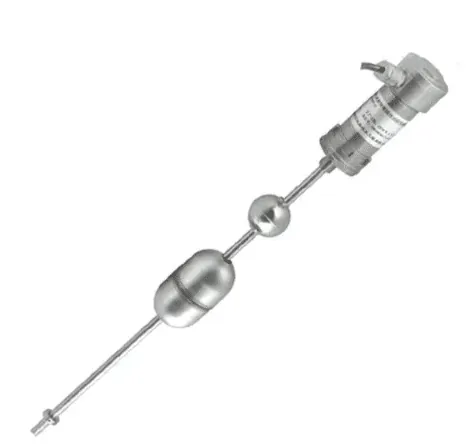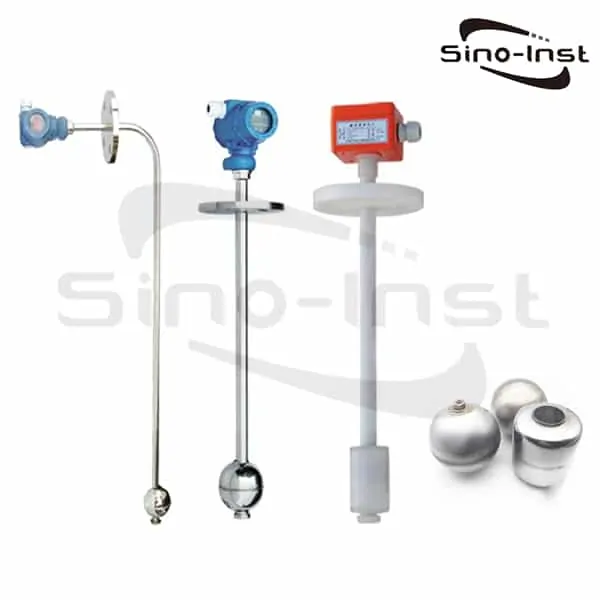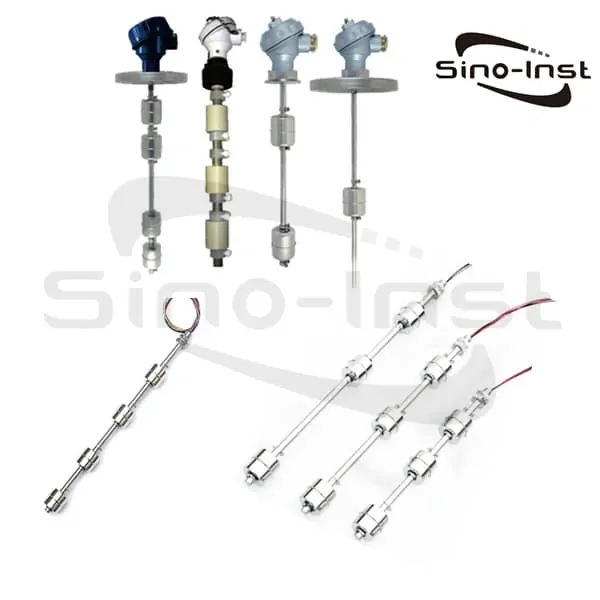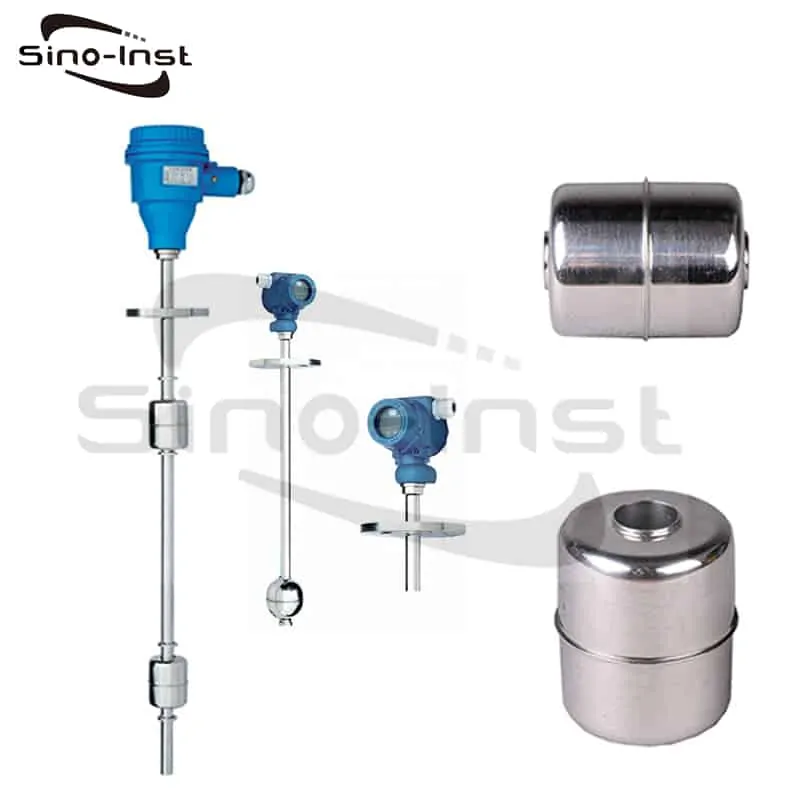The magnetostrictive level sensor comes with a mounting flange. Directly mounted on the tank flange with 4 M8 screws. Continuous Level measurement of the diesel tank/fuel tank.
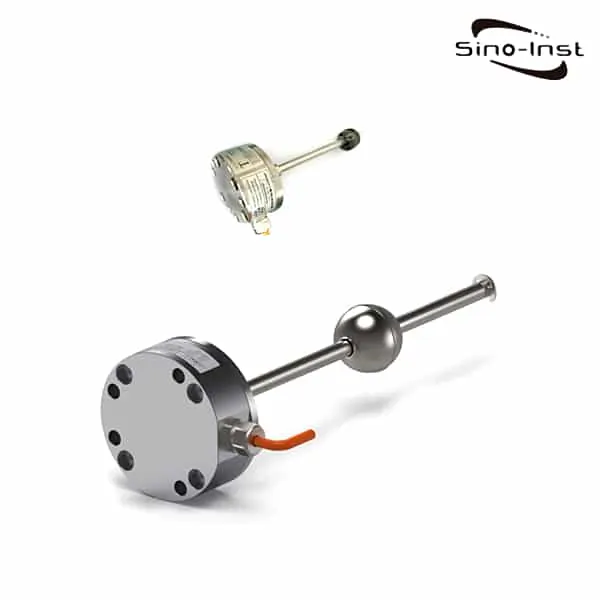
The magnetostrictive level sensor is also called the Magnetostrictive level gauge, or Magnetostrictive level transmitter. The magnetostrictive level sensor is the best choice for water, diesel, and fuel tank level measurement. LR series Integral flange Magnetostrictive level sensor is flange integrated installation. The electronic compartment of the magnetostrictive level sensor comes with a mounting flange. The sensor can be directly mounted on the tank flange with 4 M8 screws. 4 ~ 20mA \ 0 ~ 10VDC \ RTU signal \ EIA-RS485 \ RS422 optional. The magnetostrictive level sensor can be intrinsically safe and explosion-proof. A magnetostrictive level sensor measures level just like guided wave radar/ultrasonic level detectors. With Longer life and better accuracy than Hydrostatic level transmitters.
Sino-Inst offers a variety of magnetostrictive level transmitters for industrial level measurement. If you have any questions, please contact our sales engineers.
Features of Magnetostrictive level sensor
LR series integral flange type liquid level sensor. The electronic compartment has its own mounting flange. Compact structure and convenient installation. Suitable for occasions with compact installation space. Can be installed in any common liquid tank and metering equipment. The sensor can use 4 M8 screws Installed directly on the tank flange.
The sensor must be installed vertically, and the installation slope should be less than 5 degrees. There are a variety of liquid-level floats. The hemisphere marked by the float should be above the liquid surface, and there are dead zones at both ends of the measuring rod
After the sensor is installed on-site, you can set the start and endpoints of the upper and lower liquid level measurement according to the actual liquid level measurement needs through the handheld setting terminal.
● Sturdy and reliable. Waterproof and antifouling;
● Absolute output. No need for regular calibration and maintenance;
● Zero-point / full-scale point can be adjusted arbitrarily;
● Low power consumption design. Effectively reduce the system temperature drift;
● High precision. The highest 0.1mm liquid level measurement accuracy;
● Side outlet. Easy to install;
● Compact electronic warehouse. The installation height is as small as 35mm;
● Integrated flange-type electronic head. Can be directly installed at the mouth of the tank.
LR series Integral flange Magnetostrictive level sensor without local display. If you need a local display, please refer to SI-LT Magnetostrictive level transmitter with Local Digital Display
Specifications of LR series Integral flange Magnetostrictive level sensor
| Optional interface | |||
|---|---|---|---|
| Optional interface | Analog-current | Analog-voltage | Modbus |
| output signal | 4~20mA;0~20mA | 0~10V; 0~5V; -10V~10V | RTU signal,EIA-RS485/RS422 |
| General parameters | |
|---|---|
| Installation method | Flange installation (4-M8), installation slope≤5 ° |
| Measuring range | 50mm ~ 3000mm |
| Measurement parameters | Non-linearity < ± 0.05 % F.S., Repeat accuracy < ± 0.002 % F.S. |
| Protection ability | Straight cable: IP68, aviation plug: IP65 |
| Operating temperature | -40 ℃ ~ + 85 ℃ |
| Operating Voltage | 24VDC (-15 / + 20%) |
| Optional float | The minimum diameter of the float is 17.5mm, the maximum pressure is 2.5Mpa, and the minimum density is 0.45 |
Extended reading: Diesel Tank Level Monitoring System
The dimension of Integral flange Magnetostrictive level sensor

Applications of Integral flange Magnetostrictive level sensor
- Robust stainless steel fully sealed structure
- Absolute position output
- Non-contact measurement, permanent wear-proof
- Low consumption design ensures low-temperature drift of the system
Learn more about Diesel fuel tank level gauges & Indicators
Installations of LR series Integral flange Magnetostrictive level sensor

For other installation methods of Magnetostrictive level sensor, please refer to the figure below.

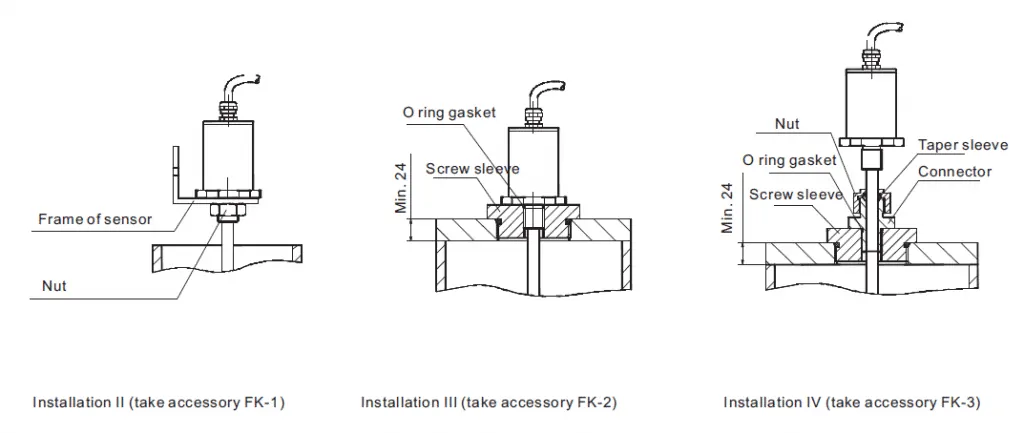
Wiring Information

Magnetostrictive level sensor design
A magnetostrictive level sensor is composed of stainless steel (measuring rod), magnetostrictive wire (sensitive element-waveguide wire), movable float (with permanent magnet inside), and other parts. With the HART protocol, the zero point and range can be adjusted remotely. Various parameters can also be adjusted through the three buttons in the cabinet and the LCD. Configurable parameters include unit, display upper and lower limits, damping, translation correction, calibration upper and lower limits, digital and analog fine-tuning correction, and factory reset.
Extended reading: level sensors for fuel tanks
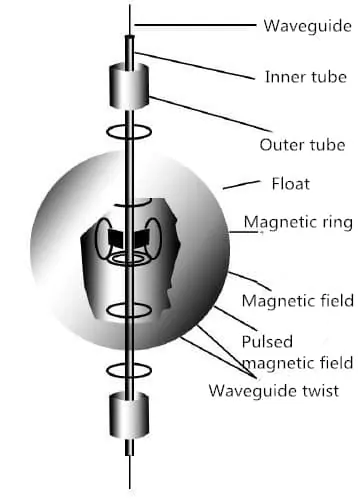
What is magnetostrictive sensor?

The magnetostrictive sensor is a high-precision, ultra-long stroke absolute position measurement sensor. It is manufactured using the principle of magnetostriction. The magnetostrictive sensor is non-contact and never wears out. High resolution, high precision. High stability, high reliability, fast response time, and long working life. The level sensor with the principle of magnetostriction and high-resolution measurement is used for continuous level measurement. And the position of the magnetic float is determined based on the principle of magnetostriction measurement.
Special features
- Continuous level measurement on the outside of the bypass
- 2-wire technology 4 … 20 mA
- Measured value output via digital interface and a selectable measured value as analogue signal
- Case from stainless steel (display from glass)
- Magnetostrictive level measuring instrument with high resolution
Applications
- Sensor for continuous level measurement of liquids in bypass level indicators
- Chemical and petrochemical industries, offshore
- Shipbuilding, machine building
- Power generating equipment, power plants
- Pharmaceutical, food, water treatment, environmental engineering industries.
Extended Reading: Guide and Selection for Diesel Fuel Flow Meters
How does A Magnetostrictive Sensor work?
- When the sensor of the magnetostrictive level transmitter works, the circuit part of the sensor will excite a pulse current on the waveguide wire.
- When this current propagates along the waveguide wire, a pulsed current magnetic field is generated around the waveguide wire.
- There is a float outside the sensor rod of the magnetostrictive liquid level gauge. This float can move up and down along the rod with the change of liquid level.
- Inside the float there is a set of permanent magnetic rings. When the pulsed current magnetic field and the magnetic ring magnetic field generated by the float want to meet. The magnetic field around the float changes so that the waveguide wire made of magnetostrictive material generates a torsional wave pulse at the position of the float.
- This pulse is transmitted back along the waveguide wire at a fixed speed and detected by the detection mechanism.
- The position of the float, that is, the position of the liquid surface can be accurately determined by measuring the time difference between the pulse current and the torsional wave.
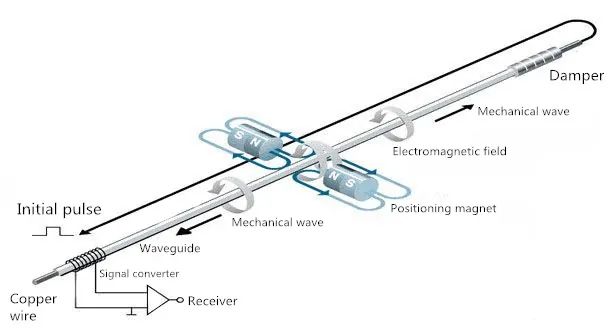
Read more about: How to Choose the Right Diesel Fuel Level Sensor ?
More Level Senors for Tank Level Measurement
A tank level sensor is a level sensor used to measure the tank level. The liquid level is the level of the liquid in a sealed container (such as a water tank) or an open container (water tank). The instrument that measures the liquid level is called a liquid level sensor, a liquid level gauge, or a liquid level transmitter. The liquid level sensor is a kind of level instrument. Hydrostatic, Ultrasonic, Magnetostrictive, Radar, Differential Pressure are common choices for tank level measurement. Liquid level sensors have been around for decades for leak detection or level measurement. Commonly measured mediums are Water, Fuel, Diesel, Gasoline, diesel, liquefied gas, liquid ammonia, etc. More about Level Senors for Tank Level Measurement.
Radar level transmitter
Radar level transmitter, also called Radar level gauge. Non-contact Continuous level measurement in liquids and solids with free space radar sensors. Non-contacting radar, based on microwave technology, detects only surfaces that reflect energy. These transmitters work on the principle of radar by using radio wave emissions. Mounted at the top of a tank filled with a liquid. The transmitter sends a radar signal into the liquid and receives a reflection of the signal. The transmitters then analyze the current fill level of the tank based on the time taken by the transmitted signal to return.
GWR level transmitter
Guided Wave Radar (GWR) Level Transmitters, also called wave guided radar level transmitters. Using guided wave radar technology, GWR level transmitters have no moving parts. They can measure both levels and the interface between two media. Continuous level measurement in liquids and solids with guided wave radar sensors. These transmitters work by sending a microwave pulse through a sensor cable or rod. The signal hits the surface of the liquid, and travels back to the sensor, and then to the transmitter housing. Based on the time taken by the signal to travel down the sensor and back up again. The electronics integrated into the transmitter housing determine the filling level.
Hydrostatic level transmitter
Hydrostatic level transmitters are also called submersible level transmitters, or pressure level transmitters. For Hydrostatic level measurement, Continuous level measurement in liquid applications with pressure sensors. These transmitters help in determining the fluid level of a container. By measuring the pressure of the resting body of the fluid within it.
Ultrasonic level transmitter
Ultrasonic Level Indicator, also called Ultrasonic level sensor, or ultrasonic level transmitter. In this type of transmitter, an ultrasonic transducer is mounted at, or near the top of a container containing liquid. The transducer sends out an ultrasonic pulse. The pulse hits the surface of the liquid and gets reflected. The sensor then calculates the fill level based on the time between the transmitted and received signal.
Extended reading: Diesel fuel tank level gauges & indicators
You may like:
Many people may confuse the float level sensor with the magnetostrictive level sensor. Because they look alike. But the actual working principle is different.
FAQ
How does a level transmitter work?
The level of the liquid medium in the container is called the liquid level. And the instrument that measures the liquid level is called the liquid level transmitter. Level transmitter is a kind of level instrument. There are two types of level transmitterss, one is continuous and the other is point-off. The continuous level transmitter is a real-time monitor of the height of the liquid in the container. The point type, which generally takes two points, high and low, and outputs an alarm signal when the medium in the container reaches these two points.The types of liquid level transmitters is very wide. Specific include: magnetic flap liquid level gauge, tuning fork vibration type, differential pressure type, pressure type. Ultrasonic, magnetostrictive liquid level gauge, magnetic flap, radar and so on.
Levels of media such as: water, viscous fluids, and fuels, or dry media such as bulk solids and powders can be measured using the transmitter.
Level measurement transmitter are used in a myriad of applications that require level measurement within containers or tanks. These transmitters often find their application in material handling, food and beverage, power, chemical, and water treatment industries.
What is radar level transmitter?
Radar level transmitter is a kind of liquid level transmitter which uses the principle of radar operation.
Radar Level Sensor also called radar level transmitter, are the indicating transmitter for liquid level.
Non-contact Continuous level measurement in liquids and solids with free space radar sensors.
RADAR (Radio Detection And Ranging) is a device which can detect the presence of faraway objects by obtaining a reflection of electromagnetic waves emitted from the device itself. Although invented much earlier, wide deployment of radar was done by Britain during the Second World War to detect oncoming German bombers.
Radar level measurement is a safe solution. Even under extreme process conditions (pressure, temperature) and vapors. Various antenna versions for every kind of radar applications are available.
In continuous non-contact level measurement with radar, the sensor sends microwave signals towards the medium from above. The surface of the medium reflects the signals back in the direction of the sensor. Using the received microwave signals, the sensor determines the distance to the product surface and calculates the level from it.
How does capacitance level measurement work?
Capacitive level sensor is a device that converts the change of the measured object position into capacitance. Capacitance level gauge has simple structure, high resolution, reliable operation and fast dynamic response. It can be measured non-contact, and can work under harsh conditions such as high temperature, radiation and strong vibration. It has been applied in various fields of industrial and agricultural production. But traditional capacitive level meters all use analog circuits. Because the dielectric constant of the measured medium changes. Stray capacitive interference. Temperature drift. Influence of scraping and other factors. The application range of the traditional capacitive liquid level gauge is limited.
Sino-Instrument offers magnetostrictive level sensor products. About 21% of these are sensors.
A wide variety of magnetostrictive level sensor options are available to you, such as analog sensor, digital sensor. You can also choose from intrinsically safe and explosion-proof. There are over 12 magnetostrictive level sensors w can supply. Magnetostrictive level sensor products are most popular in North America, Eastern Asia, and Africa.
You can ensure product safety by selecting from certified suppliers, including with ISO9001 certification. Customers choose us because our products have the best price, the best Cost-effective, and the best service.
Request a Quote

Wu Peng, born in 1980, is a highly respected and accomplished male engineer with extensive experience in the field of automation. With over 20 years of industry experience, Wu has made significant contributions to both academia and engineering projects.
Throughout his career, Wu Peng has participated in numerous national and international engineering projects. Some of his most notable projects include the development of an intelligent control system for oil refineries, the design of a cutting-edge distributed control system for petrochemical plants, and the optimization of control algorithms for natural gas pipelines.

